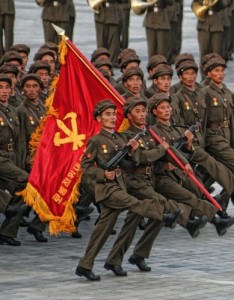Forecast: More of the same from North Korea
The Pentagon’s homework assignment was to tell Congress about North Korea’s strategic intentions and military capabilities. The report delivered to Congress today (five months late) offers a bleak prediction of North Korea’s likely behavior under Kim Jong Un. The analysis is based largely on developments through mid-2012, the exceptions being brief references added in editing to the December Taepo Dong 2 missile launch and the February nuclear test. Here are excerpts from the unclassified version, “Military and Security Developments Involving the Democratic People’s Republic of Korea”:
• “Under Kim Jong Il, DPRK strategy had been focused on internal security; coercive diplomacy to compel acceptance of its diplomatic, economic and security interests...We anticipate these strategic goals will be consistent under North Korea’s new leader, Kim Jong Un.”
• North Korea “retains the capability to inflict
serious damage on the ROK, despite significant
resource shortfalls and aging hardware.”
• “North Korea’s continued pursuit of nuclear technology and capabilities and development of long range ballistic missile programs, as reflected in the December 2012 Taepo Dong 2 missile launch and April 2012 display of a new road-mobile intercontinental ballistic missile, underscores the threat to regional stability and U.S. national security posed by North Korea.”
• “The regime’s greatest security concern is opposition from within, and outside forces – primarily South Korea – taking advantage of internal instability to topple the regime and achieve unification of the Korean Peninsula.”
• “In North Korea’s view, the destruction of regimes such as Ceausescu, Hussain, and Qadhafi was not an inevitable consequence of repressive governments, but rather a failure to secure the necessary capabilities to defend their respective autocratic regime’s survival.”
• “The DPRK seeks recognition as an equal and legitimate international player and as recognized nuclear power that is eventually able to normalize its diplomatic relations with the Western world and pursue economic recovery and prosperity. The DPRK’s rhetoric suggests the regime at this time is unlikely to pursue this second goal, at the expense of the primary goal of pursuing its nuclear and missile capabilities.”
• “…North Korea uses small-scale attacks to gain psychological advantage in diplomacy and win limited political and economic concessions, all while likely believing it can control escalation.”
• “North Korea is making some efforts to upgrade its conventional weapons. It has reinforced long-range artillery forces near the DMZ and has a substantial number of mobile ballistic missiles that could strike a variety of targets in the ROK and Japan. However, we assess that the DPRK’s emphasis will be to leverage the perception of a nuclear deterrent to counter technologically superior forces. “
• “North Korea probably has a military computer network operations (CNO) capability. Implicated in several cyber attacks ranging from computer network exploitation (CNE) to distributed denial of service (DDoS) attacks since 2009, the North Korean regime may view CNO as an appealing platform from which to collect intelligence.”
• “…a space launch does not test a re-entry vehicle (RV), without which North Korea cannot deliver a weapon to target from an ICBM. Development also continues on a new solid-propellant short-range ballistic missile (SRBM).”



